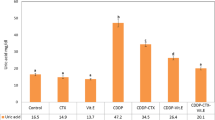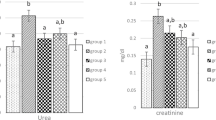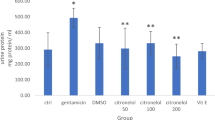Abstract
First-, second-, and third-generation cephalosporins were investigated for their peroxidative and nephrotoxic potential. Renal cortical slices from male Wistar rats were incubated at 37° C for 1 h in a phosphate-buffered medium containing the cephalosporin (1.25, 2.5, 5 or 10 mg/ml). In another series of experiments 5 mg/ml cephalosporin was incubated under the same conditions for 30, 60, 90 and 120 min. Subsequently, slices were incubated for 60 or 90 min in a bicarbonate- or phosphate-buffered medium containing pyruvate or tetraethylammonium (TEA) to determine gluconeogenesis and TEA accumulation, respectively. The peroxidative potential was determined at the end of the first incubation by measuring the increase in the malondialdehyde (MDA) content in renal cortical slices. The nephrotoxic potential was determined at the end of the second incubation by measuring the decrease in accumulation of the organic ion (TEA) and decrease of pyruvate-stimulated gluconeogenesis in renal cortical slices. First-generation cephalosporins, cephaloridine and cephalothin showed a time- and concentration-dependent increase in MDA content and a decrease in TEA accumulation and gluconeogenesis by renal cortical slices. Cefazolin, another first generation cephalosporin, showed a weak peroxidative and practically no nephrotoxic potential. In the group of second-generation cephalosporins, cefotiam showed a weak peroxidative potential comparable to that of cefoxitin but had a much greater nephrotoxic potential which was similar to that of cephaloridine. The third-generation cephalosporins, cefotaxime and cefoperazone showed a low peroxidative and no nephrotoxic potential. Based on their nephrotoxic potential, the cephalosporins investigated in the present study could be ranked as follows: cephaloridine > cefotiam > cephalothin > cefoxitin > cefazolin > cefoperazone ≧ cefotaxime.
Similar content being viewed by others
References
Alitalo R, Ruutu M, Valtonen V, Lehtonen T, Pentikäinen PJ (1985) Hypoprothrombinaemia and bleeding during administration of cefamandole and cefoperazone. Ann Clin Res 17: 116–119
Atkinson RM, Currie JP, Davis B, Pratt PAH, Sharpe HM, Tomich EG (1966) Acute toxicity of cephaloridine, an antibiotic derived from cephalosporin. Toxicol Appl Pharmacol 8: 398–406
Balant L, Dayer P, Auckenthaler R (1985) Clinical pharmacokinetics of the third generation cephalosporins. Clin Pharmacokinet 10: 101–143
Baxter JH (1948) Hepatic and renal injury with calcium deposits and cirrhosis produced in rats by pyridine. Am J Pathol 8: 407–428
Beuning MK, Wold JS, Israel KS, Kammer RB (1981) Disulfiram-like reactions to β-lactams. JAMA 245: 2027
Boyd JF, Butcher BT, Stewart GT (1973) The nephrotoxic effect of cephaloridine and its polymers. Int J Clin Pharmacol 7: 307–315
Buege JA, Aust SD (1978) Microsomal lipid peroxidation. Methods Enzymol 52: 302–310
Cojocel C, Inselmann G, Laeschke KH, Baumann K (1984) Species differences in cephalosporin-induced lipid peroxidation. Drugs Exp Clin Res 10: 781–788
Cojocel C, Laeschke KH, Inselmann G, Baumann K (1985a) Inhibition of cephaloridine-induced lipid peroxidation. Toxicology 35: 295–305
Cojocel C, Hannemann J, Baumann K (1985b) Cephaloridine-induced lipid peroxidation initiated by reactive oxygen species as a possible mechanism of cephaloridine nephrotoxicity. Biochim Biophys Acta 834: 402–410
Cross RJ, Taggart JV (1950) Renal tubular transport: accumulation of p-aminohippurate by rabbit kidney slices. Am J Physiol 161: 181–190
Dunn GL (1982) Ceftizoxime and other third-generation cephalosporins: Structure-activity relationships. J Antimicrob Chemother 10: 1–10
Ford RD (1975) Cephaloridine, cephalothin and the kidney. J Antimicrob Chemother 1: 119–133
Goldstein RS, Pasino DA, Hewitt WR, Hook JB (1986) Biochemical mechanisms of cephaloridine nephrotoxicity: time and concentration dependence of peroxidative injury. Toxicol Appl Pharmacol 83: 261–270
Hori R, Ishikawa Y, Takano M, Okano T, Kitazawa S, Inui K-I (1982) The interaction of cephalosporin antibiotics with renal cortex of rats: accumulation to cortical slices and binding to purified plasma membranes. Biochem Pharmacol 31: 2267–2272
Kamei C, Sunami A, Tasaka K (1983) Epileptogenic activity of cephalosporins in rats and their structure-activity relationship. Epilepsia 24: 431–439
Kerremans AL, Lipski JJ, VanLoon J, Galego MO, Weinshilboum RM (1985) Cephalosporin-induced hypoprothrombinemia: possible role for thiol methylation of 1-methyltetrazole-5-thiole and 2-methyl-1,2,4-thiadiazole-5-thiol. J Pharmacol Exp Ther 235: 382–388
Koch H (1983) Cefotiam: second-generation cephalosporin antibiotic. Pharmacy Intern 4: 50–51
Kuo C-H, Hook JB (1982) Depletion of renal glutathione content and nephrotoxicity of cephaloridine in rabbits, rats and mice. Toxicol Appl Pharmacol 63: 292–302
Kuo C-H, Maita K, Sleight SD, Hook JB (1983) Lipid peroxidation: a possible mechanism of cephaloridine-induced nephrotoxicity. Toxicol Appl Pharmacol 67: 78–88
Lipski JJ, Lewis JC, Novick WJ Jr (1984) Production of hypoprothrombinemia by moxalactam and 1-methyl-5-thiotetrazole in rats. Antimicrob Agents Chemother 25: 380–381
Lipski JJ, Lewis JC, Novick WJ Jr (1986) Production of hypoprothrombinaemia by cephazolin and 2-methyl-1,3,4-thiadiazole-5-thiol in the rat. J Antimicrob Chemother 18: 131–137
Mandell GL (1973) Cephaloridine. Ann Int Med 79: 561–565
McMurty RJ, Mitchell JR (1977) Renal and hepatic necrosis after metabolic activation of 2-substituted furans and thiophenes, including furosemide and cephaloridine. Toxicol Appl Pharmacol 42: 285–300
Masuda Y, Nakayama N, Yamaguchi A, Murohashi M (1984) The effects of diethyldithiocarbamate and carbon disulfide on acute nephrotoxicity induced by furan, brombenzene and cephaloridine in mice. Japan J Pharmacol 34: 221–229
Nakai Y, Chiba S, Suhara I, Miyajima H, Yamazaki M, Takano K (1983) Nephrotoxicity of cefotiam in rats. Infection 11: 283–285
Neu HC (1983) Adverse effects of new cephalosporins. Ann Int Med 981: 415–416
Neu HC (1984) Do we need third-generation cephalosporins? J Antimicrob Chemother 14: 1–12
Portier H, Chalopin JM, Freysz M, Tanter Y (1980) Interactions between cephalosporins and alcohol. Lancet ii: 263
Richmond MH, Sykes RB (1973) The β-lactamases of Gram-negative bacteria and their possible physiological role. Adv Microb Physiol 9: 31–85
Roobol A, Alleyne GAO (1974) Control of renal cortex ammoniagenesis and relationship to renal cortex gluconeogenesis. Biochim Biophys Acta 362: 83–91
Schmidt FH (1961) Die enzymatische Bestimmung von Glucose und Fructose nebeneinander. Klin Wschr 39: 1244–1247
Stewart GT, Holt RJ (1964) Laboratory and clinical results with cephaloridine. Lancet IV: 1305–1309
Sykes RB, Matthew M (1976) The β-lactamases of Gram-negative bacteria and their role in resistance to β-lactam antibiotics. J Antimicrob Chemother 19: 454–460
Tune BM, Fravert D (1980a) Mechanisms of cephalosporin nephrotoxicity: a comparison of cephaloridine and cephaloglycin. Kidney Int 18: 591–600
Tune BM, Fravert D (1980b) Cephalosporin nephrotoxicity: transport, cytotoxicity and mitochondrial toxicity of cephaloglycin. J Pharmacol Exp Ther 215: 186–190
Tune BM, Kuo C-H, Hook JB, Hsu C-Y, Fravert D (1982a) Effects of piperonyl butoxide on cephalosporin nephrotoxicity in the rabbit. An effect on cephaloridine transport. J Pharmacol Exp Ther 224: 520–524
Tune BM, Browning MC, Hsu C-Y, Fravert D (1982b) Prevention of cephalosporin nephrotoxicity by other cephalosporins and by penicillins without significant inhibition of renal cortical uptake. J Infect Dis 145: 174–180
Wachsmuth ED (1981) Nephrotoxicity of cefotiam (CGP 14221/E) in rats and rabbits. Arch Toxicol 48: 135–156
Wells JS, Gibson WR, Harris PN, Small RM, Anderson RC (1966) Toxicity distribution and excretion of cephaloridine in laboratory animals. Antimicrob Agents Chemother 1965: 863–869
Author information
Authors and Affiliations
Rights and permissions
About this article
Cite this article
Cojocel, C., Göttsche, U., Tölle, KL. et al. Nephrotoxic potential of first-, second-, and third-generation cephalosporins. Arch Toxicol 62, 458–464 (1988). https://doi.org/10.1007/BF00288350
Received:
Revised:
Accepted:
Issue Date:
DOI: https://doi.org/10.1007/BF00288350




